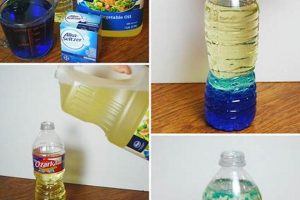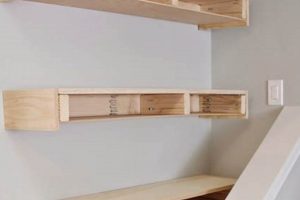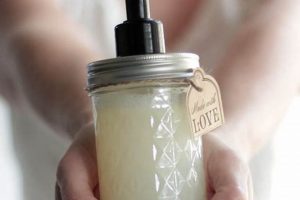A do-it-yourself shower base constitutes a waterproof structure installed beneath the shower floor. It serves as a critical element in bathroom construction, collecting water and directing it toward the drain. The fabrication process often involves assembling pre-sloped foam panels or pouring a concrete mortar bed to create the necessary gradient for drainage.
Properly constructed shower bases are essential for preventing water damage, mold growth, and structural deterioration within the bathroom. Historically, these structures relied heavily on lead pans or multi-layered waterproofing membranes applied by skilled tradespeople. Contemporary approaches emphasize simplified installation techniques and readily available materials, enabling informed individuals to undertake the construction process.
The subsequent discussion will delve into the materials, techniques, and considerations necessary for achieving a reliable and long-lasting waterproof barrier within a shower enclosure. Topics include substrate preparation, waterproofing methods, and appropriate drainage systems to ensure a successful build.
Essential Considerations for Shower Base Construction
Successful shower base construction relies on meticulous planning and execution. The following guidelines will contribute to a durable, leak-proof installation.
Tip 1: Substrate Preparation: The subfloor must be level, structurally sound, and free from debris. Uneven surfaces can compromise the integrity of the waterproof membrane. Thorough cleaning and leveling are essential before proceeding.
Tip 2: Waterproofing Membrane Selection: Choose a waterproofing membrane compatible with the substrate and intended use. Options include liquid-applied membranes, sheet membranes, and cementitious coatings. Each possesses unique properties regarding permeability, flexibility, and application requirements. Research and select according to project specifics.
Tip 3: Proper Slope for Drainage: Accurate sloping towards the drain is crucial for effective water evacuation. A minimum slope of inch per foot is generally recommended. Utilize a leveling device and measuring tools to ensure consistent gradient across the entire surface.
Tip 4: Drain Assembly Installation: Install the shower drain assembly precisely according to the manufacturer’s instructions. Ensure a watertight seal between the drain flange and the waterproofing membrane. Neglecting this step will inevitably lead to leaks.
Tip 5: Curing Time: Allow sufficient curing time for all materials, including the waterproofing membrane and mortar bed. Premature loading can compromise the bond strength and lead to premature failure. Consult product datasheets for recommended curing durations.
Tip 6: Flood Testing: Conduct a flood test before installing the shower enclosure. Plug the drain and fill the base with water to the level of the curb for 24-48 hours. Monitor for any signs of leakage in adjacent areas. Rectify any leaks detected before proceeding.
Tip 7: Mortar Bed Reinforcement: When utilizing a traditional mortar bed, incorporate wire mesh or fiber reinforcement to enhance crack resistance. This is especially important for larger bases or areas prone to movement.
Adherence to these principles minimizes the risk of water damage and extends the lifespan of the shower installation. Precise execution and attention to detail are paramount.
The subsequent sections will address specific material choices and their impact on the longevity of the finished shower.
1. Waterproofing
Waterproofing represents a non-negotiable component of any self-constructed shower base. The purpose of a shower is to contain and direct water; thus, the effectiveness of the waterproofing directly determines the lifespan and structural integrity of the bathroom and surrounding areas. Failure in this area results in water penetration, leading to mold growth, wood rot, drywall damage, and potential structural compromises to the building itself. Selecting and applying a reliable waterproofing system is therefore the most critical decision in any DIY shower pan project. A common scenario illustrating this importance involves improperly applied liquid membrane, resulting in pinholes and weak spots. Over time, water seeps through these imperfections, causing unseen damage beneath the tile and potentially requiring costly and extensive repairs.
The connection between waterproofing and the self-built shower base extends beyond simple material application. It necessitates a thorough understanding of substrate compatibility, membrane selection, and proper installation techniques. For example, using a non-modified mortar over a waterproof membrane can lead to bond failure due to lack of proper adhesion. Furthermore, detailing around penetrations, such as the drain flange and mixing valve plumbing, requires specialized attention and often necessitates reinforcing the waterproofing with specialized products like reinforcing fabric or pre-formed corners. Understanding industry best practices regarding overlaps, minimum thickness requirements, and proper curing times is essential for ensuring a robust, waterproof barrier.
In summary, the connection between waterproofing and a self-installed shower pan is a direct causal relationship: inadequate waterproofing directly causes water damage, whereas effective waterproofing preserves the bathroom structure. While the choice of materials and the difficulty of installation can present challenges, ignoring or underestimating the importance of waterproofing guarantees future problems. Proper planning, material selection, and diligent execution of the waterproofing stage are fundamental to a successful and long-lasting shower installation.
2. Proper Slope
The establishment of an adequate and consistent gradient, commonly referred to as “proper slope,” constitutes a critical element in the successful construction of a self-installed shower base. This gradient facilitates the efficient drainage of water toward the drain, preventing ponding and the subsequent risks associated with prolonged moisture exposure. Insufficient slope, even if seemingly minor, can lead to standing water, fostering the growth of mold and mildew, degrading grout lines, and potentially compromising the integrity of the substrate materials. Such consequences necessitate costly remediation efforts and undermine the longevity of the shower installation.
The correlation between proper slope and the longevity of the base directly affects the choice of construction methodology and the selection of materials. Traditional mortar bed installations necessitate precise leveling techniques and careful attention to establishing the correct gradient during the screeding process. Pre-sloped foam pans offer an alternative, streamlining the process by providing a pre-fabricated slope, albeit often requiring modifications to accommodate specific drain locations o
r shower dimensions. Regardless of the chosen method, the accurate measurement and verification of the slope using levels and measuring tools remain indispensable. A lack of attention to these details, even with the most advanced waterproofing membranes, renders the system vulnerable to moisture damage.
In summation, proper slope is not merely a desirable feature but a fundamental requirement for a durable shower base. Its absence initiates a cascade of adverse effects, from aesthetic degradation to structural compromise. Diligence in establishing and verifying the slope during the installation process represents a crucial investment in the long-term performance of the self-constructed shower. Overlooking this detail inevitably results in recurring maintenance costs and potentially extensive repairs, thereby negating the cost savings initially sought through a do-it-yourself approach.
3. Drain Connection
The integrity of the drain connection is paramount to the functionality and longevity of any self-constructed shower base. Its purpose is to provide a watertight conduit for wastewater removal, preventing leakage into the subfloor and surrounding structures. A deficient drain connection constitutes a primary failure point in shower installations, leading to significant structural damage and potential health hazards.
- Compatibility and Material Selection
Drain compatibility with the selected shower base material and plumbing system is crucial. Options include PVC, ABS, and cast iron. Mixing incompatible materials can lead to corrosion and eventual failure. The selected drain must also meet plumbing code requirements and accommodate the thickness of the shower base assembly.
- Watertight Sealing
Achieving a reliable watertight seal between the drain flange, waterproofing membrane, and drainpipe is non-negotiable. This typically involves the use of specialized sealants, rubber gaskets, and clamping mechanisms. The drain flange must be securely fastened to the shower base to prevent movement and maintain the seal over time.
- Proper Installation Techniques
Adherence to manufacturer instructions and established plumbing practices is essential for proper drain installation. This includes proper pipe threading, solvent welding, and torque specifications. Overtightening or undertightening fittings can compromise the seal and lead to leaks. Alignment of the drain assembly with the surrounding shower base is critical to ensure proper water flow.
- Accessibility for Maintenance
The drain assembly should be designed to allow for future maintenance and cleaning. Removable strainers and access panels can facilitate the removal of debris and prevent clogs. Consideration should be given to accessing the drain from below the shower base, if possible, for more extensive repairs.
Neglecting any of these aspects in drain connection during a self-constructed shower base installation invariably leads to water damage. The drain system is a foundational element, and a compromised connection undermines the entire shower assembly. Careful planning, meticulous execution, and adherence to established plumbing standards are required to ensure a durable and watertight drain connection.
4. Substrate Stability
Substrate stability directly impacts the longevity and water resistance of a self-constructed shower base. The substrate, the underlying structural layer upon which the shower base is built, provides essential support for all subsequent layers, including the waterproofing membrane, mortar bed (if applicable), and tiling. Instability in this foundational element transmits stresses upwards, potentially leading to cracks in the mortar bed, compromised waterproofing, and eventual tile failure. An example of this phenomenon is evident in instances where a shower is built upon a subfloor with excessive deflection. The weight of the completed shower, combined with the weight of the user and water, causes the subfloor to bend slightly, resulting in stress fractures in the mortar bed and subsequent leaks.
The selection and preparation of the substrate materials are critical for ensuring adequate stability. Oriented strand board (OSB) or plywood, common subfloor materials, must meet minimum thickness requirements based on joist spacing to minimize deflection. Moreover, ensuring the substrate is level and free from imperfections is crucial for achieving a uniform mortar bed thickness. Deviations in substrate flatness can lead to localized stress concentrations and premature failure. Before commencing with the waterproofing process, any existing damage or irregularities in the substrate must be addressed, potentially involving reinforcing the subfloor or applying a self-leveling compound. Ignoring these preparatory steps significantly increases the risk of future problems.
In conclusion, substrate stability represents a non-negotiable prerequisite for a durable shower base. Instability in the foundational layer undermines the integrity of the entire shower assembly. Thorough assessment of the substrate’s condition, selection of appropriate materials, and meticulous preparation are essential for mitigating the risk of future water damage and ensuring a long-lasting, watertight shower installation. The cost associated with reinforcing or leveling the substrate is minimal compared to the expenses associated with repairing a failed shower base.
5. Membrane Choice
The selection of a suitable waterproofing membrane exerts a direct and significant influence on the performance and longevity of a self-constructed shower base. The membrane serves as the primary barrier against water penetration, mitigating the risk of structural damage and mold growth. Inappropriate membrane selection, stemming from inadequate research or cost-driven compromises, precipitates premature failure of the shower assembly. For instance, utilizing a non-modified thin-set mortar directly over a sheet membrane can result in poor adhesion, leading to tile detachment and water intrusion. Similarly, choosing a membrane with insufficient crack bridging capabilities in areas prone to movement can lead to tears and subsequent leaks.
The consequences of a poorly chosen membrane extend beyond simple water damage; they impact the entire bathroom environment. Water migration into the subfloor can compromise structural integrity, necessitating extensive repairs and potentially leading to health issues due to mold proliferation. The financial burden of remediation, encompassing demolition, reconstruction, and mold removal, substantially exceeds the initial cost savings associated with selecting a cheaper, less suitable membrane. A case in point involves using a liquid-applied membrane with inadequate permeability in a steam shower environment, where the constant exposure to moisture and heat causes the membrane to break down over time, leading to significant water damage behind the tile.
In conclusion, membrane choice represents a critical decision point in the construction of a durable self-installed shower base. The long-term performance of the shower directly correlates with the suitability of the selected membrane for the specific applic
ation. A thorough understanding of membrane properties, substrate compatibility, and installation requirements is essential for mitigating the risks of water damage and ensuring a long-lasting, watertight shower installation. The additional investment in a high-quality, appropriate membrane constitutes a prudent safeguard against costly future repairs and potential health hazards.
6. Curing Time
Curing time represents a critical, often underestimated, parameter in the successful construction of a do-it-yourself shower base. This period denotes the time required for various materials, such as mortar beds, waterproofing membranes, and adhesives, to achieve their designed strength, bond, and chemical properties. Premature loading or use of the shower before the completion of the curing process can lead to structural weaknesses, compromised waterproofing, and ultimately, premature failure of the entire shower assembly. A common example involves applying tile over a mortar bed that has not fully cured. The trapped moisture within the uncured mortar bed can weaken the bond between the tile and the mortar, leading to cracked tiles and water penetration behind the tiled surface. In addition, some waterproofing membranes require extended curing times to fully cross-link and achieve their intended waterproof properties; short-circuiting this process can render the membrane susceptible to water permeation.
The specific curing time varies significantly depending on the type of material, environmental conditions (temperature and humidity), and the manufacturer’s specifications. High humidity and low temperatures typically extend curing times, while elevated temperatures and low humidity can accelerate the process, albeit potentially compromising the material’s final properties if not carefully monitored. Adherence to the manufacturer’s guidelines regarding curing time is paramount, as deviating from these recommendations can void warranties and jeopardize the integrity of the entire shower installation. For instance, a liquid-applied waterproofing membrane might require 72 hours to fully cure under ideal conditions; reducing this time can leave the membrane vulnerable to damage during subsequent construction phases. Proper ventilation and temperature control within the bathroom can aid in optimizing the curing environment.
In summary, curing time is not merely a waiting period, but an integral component of a properly constructed self-installed shower base. Ignoring or underestimating the importance of curing time inevitably leads to compromised material performance and an increased risk of water damage. Diligent adherence to manufacturer’s specifications, coupled with careful monitoring of environmental conditions, is essential for ensuring that all materials achieve their intended properties and contribute to the long-term durability of the shower installation. The consequences of neglecting this crucial step often far outweigh the perceived time savings.
7. Code Compliance
Adherence to established building codes is not an optional consideration but a legal imperative when undertaking a do-it-yourself shower base installation. These codes, enacted and enforced by local jurisdictions, are designed to ensure the safety, health, and structural integrity of buildings. Failure to comply with relevant codes can result in rejected inspections, costly rework, fines, and potential legal liabilities.
- Drainage Requirements
Plumbing codes stipulate specific requirements for shower drain size, slope, and venting to ensure adequate wastewater removal and prevent sewer gas intrusion. Improper drain sizing or inadequate venting can lead to slow drainage, clogs, and potential health hazards. Code compliance necessitates precise measurements, appropriate pipe fittings, and adherence to prescribed installation methods.
- Waterproofing Standards
Building codes mandate the use of approved waterproofing materials and installation techniques to prevent water damage to adjacent structures. These standards typically specify minimum membrane thickness, overlap requirements, and approved application methods. Failure to adhere to these standards can result in water penetration, mold growth, and structural degradation. Inspections often involve flood testing to verify the effectiveness of the waterproofing system.
- Accessibility Regulations
Accessibility codes, such as those outlined in the Americans with Disabilities Act (ADA), prescribe minimum requirements for shower dimensions, threshold heights, and grab bar placement to ensure accessibility for individuals with disabilities. Failure to comply with these regulations can restrict usability and violate legal mandates. Design considerations must account for required clearances, maneuvering spaces, and accessible fixture heights.
- Electrical Safety
Electrical codes govern the placement of electrical outlets, lighting fixtures, and grounding requirements within the shower enclosure to mitigate the risk of electrical shock. These regulations typically mandate the use of ground fault circuit interrupters (GFCIs) and specify minimum distances between electrical components and water sources. Improper electrical installations can pose a serious safety hazard and violate building codes.
The complexities inherent in navigating building codes underscore the importance of thorough research and consultation with local building officials prior to commencing any do-it-yourself shower base project. While cost savings may be a primary motivator for undertaking such a project, non-compliance with building codes can negate these savings through rework costs, fines, and potential legal ramifications. Prioritizing code compliance ensures a safe, durable, and legally compliant shower installation.
Frequently Asked Questions
The following addresses frequently encountered questions regarding the construction of self-installed shower bases, focusing on critical aspects of design, materials, and installation practices.
Question 1: What constitutes an acceptable substrate for a self-installed shower base?
Acceptable substrates include structurally sound plywood or oriented strand board (OSB) meeting minimum thickness requirements based on joist spacing. The substrate must be level, clean, and free from any damage that could compromise the stability of the shower base.
Question 2: What is the recommended slope for a shower base to ensure proper drainage?
The industry-standard recommendation is a minimum slope of inch per foot towards the drain. Precise measurement and verification are crucial to prevent water ponding.
Question 3: Which type of waterproofing membrane offers the best protection for a self-installed shower base?
Membrane selection depends on substrate material, shower usage, and budget. Common options include liquid-applied membranes, sheet membranes, and cementitious coatings. Thorough research and adherence to manufacturer specifications are essential.
Question 4: How long should the mortar bed cure before tiling a self-installed shower base?
Curing time varies depending on mortar composition, environmental conditions, and manufacturer instructions. Typically, a minimum of 24-72 hours is required, but it’s imperative to consult the product
data sheet for specific recommendations.
Question 5: Is it necessary to conduct a flood test after installing a waterproofing membrane?
A flood test is highly recommended to verify the watertight integrity of the shower base. The drain is plugged, and the base is filled with water to the height of the curb for a period of 24-48 hours, monitoring for any leaks in surrounding areas.
Question 6: What are the common code requirements for a self-installed shower drain?
Code requirements vary by jurisdiction but typically include minimum drain size, proper venting, and use of approved materials. Consultation with local building officials is essential to ensure compliance.
Proper planning and execution are crucial for the successful construction of a self-installed shower base. Addressing potential issues early in the process minimizes the risk of costly repairs.
The subsequent section will address advanced techniques and problem-solving strategies for complex shower base installations.
Conclusion
This exploration of diy shower pan construction has highlighted the critical factors governing its success or failure. Waterproofing integrity, accurate slope, secure drain connections, substrate stability, appropriate membrane selection, adequate curing time, and strict code compliance are not merely suggestions but essential requirements. Neglecting any of these elements introduces substantial risk, potentially leading to extensive water damage and costly remediation.
The construction of a diy shower pan demands meticulous planning, precise execution, and a comprehensive understanding of relevant building codes and material properties. While potential cost savings may be attractive, the complexity and potential consequences of failure should not be underestimated. A thorough assessment of skills, resources, and local regulations is imperative before undertaking such a project. A professional consultation may prove to be a valuable investment, ensuring a durable and legally compliant shower installation.







